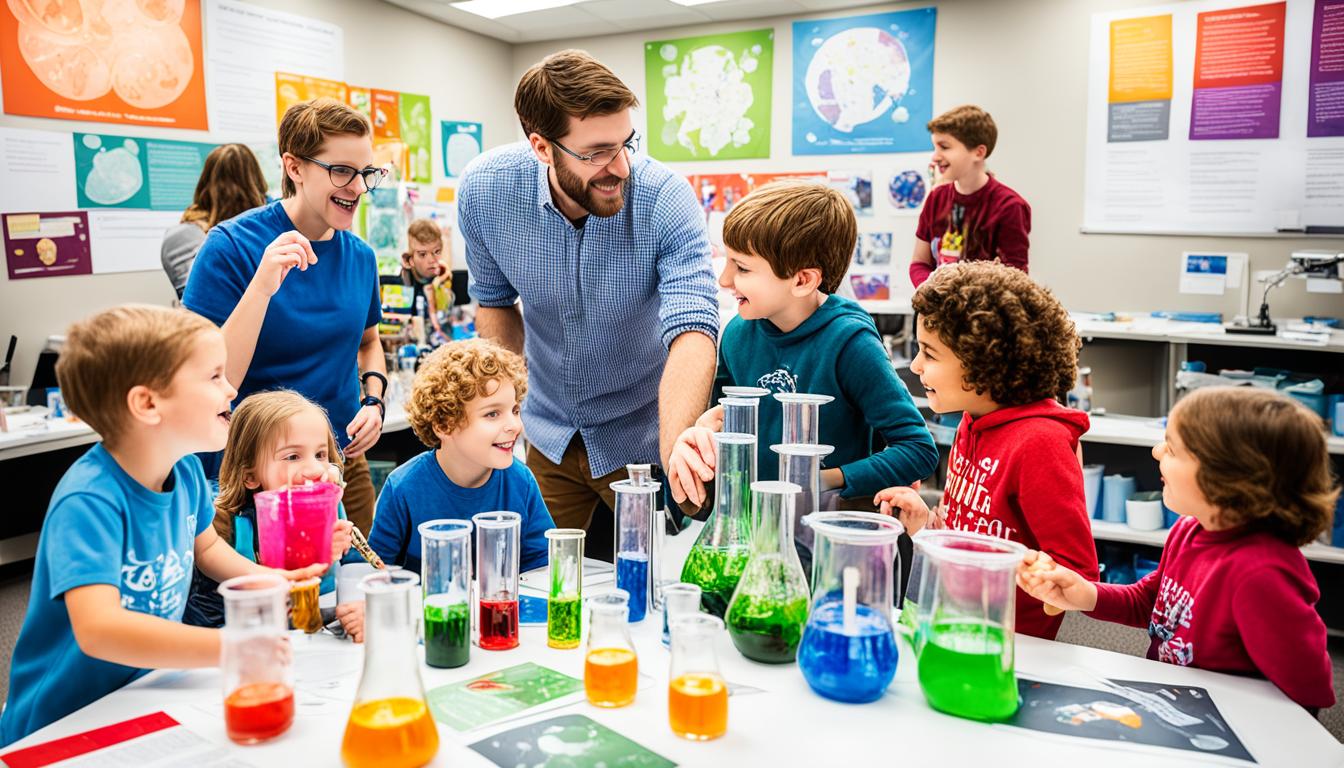When it comes to driving scientific innovation, nurturing a scientific mindset is essential. By cultivating creative thinking and embracing the power of imagination, individuals can propel themselves from mere imagination to groundbreaking innovation. In this article, we will explore the pivotal role of nurturing the scientific mindset and its impact on transforming ideas into tangible solutions.
Key Takeaways:
- Nurturing the scientific mindset involves cultivating creative thinking and embracing the power of imagination.
- By nurturing the scientific mindset, individuals can propel themselves from imagination to innovation.
- A scientific mindset plays a pivotal role in transforming ideas into tangible solutions.
- Through nurturing the scientific mindset, individuals can make significant contributions to scientific innovation.
- Creative thinking and imagination are crucial elements in driving scientific advancement.
Unlocking the Potential of the Creative and Scientific Mind
Combining imagination and analytical thinking is a powerful combination that can unlock the full potential of the creative and scientific mind. By merging these two distinct yet complementary elements, individuals are able to drive innovative ideas and make groundbreaking scientific discoveries. This unique approach of blending creativity and scientific methodologies opens up new possibilities and pushes the boundaries of knowledge.
When the creative and scientific mind converges, it paves the way for innovative thinking and scientific discovery. Creativity helps in generating new ideas, thinking outside the box, and looking at problems from different perspectives. It fuels the imagination and allows scientists to explore uncharted territories. On the other hand, analytical thinking brings structure and methodology to the creative ideas, enabling scientists to test hypotheses, conduct experiments, and analyze data.
This harmonious integration of creativity and scientific thinking is at the heart of numerous scientific breakthroughs and advancements. From the works of great inventors like Thomas Edison and Nikola Tesla to modern-day scientists, the ability to combine imagination and analytical thinking has led to astonishing scientific discoveries that have shaped our world.
“Imagination is more important than knowledge. For knowledge is limited, whereas imagination embraces the entire world, stimulating progress, giving birth to evolution.” – Albert Einstein
This quote by Albert Einstein beautifully captures the essence of the creative and scientific mind. Imagination, when coupled with scientific methodologies, has the power to revolutionize our understanding of the world and propel us toward new frontiers.
In the next section, we will delve into the vital role of critical and creative thinking skills and their integral relationship with the scientific mindset.
The Vital Role of Critical and Creative Thinking Skills
In order to fully understand the importance of critical and creative thinking skills in nurturing the scientific mindset, we need to delve into the nature of these thinking skills and their integral relationship with innovation and problem-solving.
Understanding Thinking Skills for Innovation
Thinking skills encompass a range of cognitive abilities that enable individuals to analyze, evaluate, and synthesize information, as well as generate innovative ideas. Critical thinking skills, in particular, involve analyzing and evaluating evidence, arguments, and claims to make informed decisions and solve complex problems. By honing critical thinking skills, individuals can challenge assumptions, evaluate multiple perspectives, and make reasoned judgments.
On the other hand, creative thinking involves generating novel ideas, making connections between seemingly unrelated concepts, and thinking outside the box. Creative thinking is essential for innovation as it encourages individuals to explore unconventional solutions and push the boundaries of knowledge. It enables individuals to approach problems with fresh perspectives and discover innovative solutions that can drive scientific advancements.
The Integral Nature of Creativity in Problem Solving
While critical thinking skills provide the foundation for logical reasoning and analysis, creativity plays a crucial role in problem-solving. Creative thinking allows individuals to approach problems from multiple angles, encouraging flexible thinking and the exploration of alternative solutions. It fosters the ability to think divergently and consider unconventional approaches, leading to breakthrough discoveries and innovative problem-solving.
By combining critical and creative thinking skills, individuals can nurture a scientific mindset that is primed for innovation. These thinking skills work synergistically, enabling individuals to think critically about complex issues while also unleashing their creative potential to find unique and imaginative solutions.
| Benefits of Critical Thinking Skills | Benefits of Creative Thinking Skills |
|---|---|
|
|
The table above highlights the distinct benefits of critical thinking and creative thinking skills. While critical thinking skills improve problem-solving abilities and decision-making, creative thinking skills foster innovation, expand perspectives, and encourage adaptability in problem-solving processes.
How Creativity Fuels Thinking Skills and Vice Versa
In the realm of problem-solving and innovation, creativity and thinking skills form a symbiotic relationship, each enhancing the other’s potential. Creativity fuels thinking skills by expanding perspectives and generating novel ideas, while thinking skills provide a foundation for logical reasoning and strategic planning, enhancing creativity.
“Creativity is intelligence having fun.” – Albert Einstein
When individuals tap into their creative abilities, they are able to approach challenges from different angles, thinking outside the box and pushing the boundaries of traditional solutions. By embracing creativity, they can unlock new perspectives, allowing for the exploration of unconventional ideas and approaches.
Moreover, creativity serves as a catalyst for fostering innovation. When individuals engage their creative thinking skills, they often uncover unique insights and perspectives that can lead to groundbreaking discoveries and advancements. Integrating creativity into the problem-solving process opens up opportunities for fresh, innovative solutions that can drive positive change.
On the other hand, thinking skills such as critical thinking and analytical reasoning enhance creativity by providing structure and coherence to the imaginative process. These skills enable individuals to evaluate and assess their ideas, bringing a level of clarity and precision to their creative endeavors.
Furthermore, thinking skills play a crucial role in problem-solving. By utilizing their analytical and logical thinking abilities, individuals can break down complex problems into manageable components, identify patterns, and develop systematic approaches to find solutions. These thinking skills enhance problem-solving effectiveness and efficiency, allowing for more innovative and effective outcomes.
The symbiotic relationship between creativity and thinking skills is essential for fostering innovation. By integrating these two aspects, individuals can push the boundaries of what is possible and create new solutions to existing challenges. Whether it’s in science, technology, art, or any other field, the combination of creativity and thinking skills is a powerful force for driving progress and shaping the future.
| Advantages of Creativity | Advantages of Thinking Skills |
|---|---|
| 1. Expands perspectives | 1. Provides structure and coherence |
| 2. Generates novel ideas | 2. Enhances problem-solving effectiveness |
| 3. Fuels innovation | 3. Enables logical reasoning |
| 4. Encourages exploration of unconventional solutions | 4. Identifies patterns and develops systematic approaches |
| 5. Drives positive change | 5. Improves creativity and critical thinking |
Empowering Future Scientists Through Critical Thinking Exercises
To prepare future scientists for the challenges of tomorrow, it is essential to empower them with critical thinking skills and problem-solving abilities. By engaging in a series of targeted exercises, aspiring scientists can develop the necessary mindset for scientific inquiry. Through these exercises, they will hone their critical thinking abilities and strengthen their problem-solving skills.
One effective critical thinking exercise involves presenting students with a real-world scientific problem and encouraging them to analyze the situation from different perspectives. This exercise fosters the development of analytical skills and stimulates creative thinking. Students are challenged to consider alternative solutions, evaluate evidence, and make informed decisions.
Another valuable exercise for future scientists is engaging in scientific debates and discussions. This enhances their ability to critically evaluate evidence and arguments, promoting logical reasoning and effective communication skills. By engaging in intellectual discourse and defending their viewpoints, students sharpen their critical thinking abilities.
“Critical thinking exercises offer an invaluable opportunity for future scientists to develop the skills needed for scientific inquiry and problem-solving.” – Dr. Samantha Roberts, Professor of Science Education
Problem-solving exercises are also crucial for nurturing the scientific mindset. These exercises present students with complex scientific challenges that require innovative solutions. By working collaboratively in teams, students learn to think creatively, explore multiple avenues of inquiry, and apply their scientific knowledge to develop practical solutions.
For example, a problem-solving exercise could involve designing an experiment to investigate a scientific phenomenon. Students must identify relevant variables, develop a hypothesis, and design a method to test their hypothesis. This exercise not only reinforces scientific inquiry but also encourages critical thinking and problem-solving skills.
Another effective exercise is presenting students with case studies that require them to analyze and solve real-world scientific problems. By examining these case studies, students learn to apply their scientific knowledge and analytical skills to identify solutions and make evidence-based decisions.
By incorporating critical thinking and problem-solving exercises into science education, we can empower future scientists to think critically, ask questions, and approach scientific inquiry with confidence. These exercises foster creativity, enhance analytical thinking, and equip students with the skills they need to tackle the complex challenges of the future.

| Critical Thinking Exercises | Benefits |
|---|---|
| Real-world problem analysis | Develops analytical skills and stimulates creative thinking |
| Scientific debates and discussions | Enhances critical evaluation and communication skills |
| Complex problem-solving tasks | Promotes innovative thinking and application of scientific knowledge |
| Case studies analysis | Develops evidence-based decision-making skills |
Education as a Catalyst for Student Creativity
In today’s rapidly evolving world, education plays a pivotal role in nurturing the creative potential of students. By integrating creative disciplines into STEM (Science, Technology, Engineering, and Mathematics) curriculums, educational institutions can foster the scientific mindset while encouraging innovative thinking and problem-solving skills.
Integrating Creative Disciplines into STEM Curriculums
Integrating creative disciplines, such as art, design, and music, into STEM curriculums offers a holistic approach to education. By incorporating these disciplines, students are encouraged to explore their imagination, think outside the box, and develop multidimensional perspectives. This integration not only enhances creativity but also provides a well-rounded education that prepares students for the complex challenges of the modern world.
| Benefits of Integrating Creative Disciplines into STEM Curriculums |
|---|
| 1. Cultivates creative problem-solving skills |
| 2. Enhances critical thinking and analytical abilities |
| 3. Promotes collaboration and teamwork |
| 4. Fosters innovative thinking and out-of-the-box approaches |
| 5. Provides a well-rounded education that merges artistic and scientific principles |
Student Mentorship Opportunities for Creative Development
Alongside integrating creative disciplines, offering student mentorship programs can significantly contribute to fostering creative development. Connecting students with industry professionals and experienced mentors allows them to gain valuable insights, guidance, and inspiration. Mentorship programs provide a platform for students to explore their creativity, receive constructive feedback, and develop their unique talents.
Education is not merely the imparting of knowledge, but the cultivation of creative thinking and the nurturing of individual potential.
By harnessing the power of mentorship, students can benefit from the wisdom and experiences of those who have paved the way before them. This guidance empowers them to think creatively, take risks, and overcome obstacles, ultimately unlocking their full creative potential.
Education acts as a catalyst for student creativity by blending creative disciplines into STEM curriculums and providing mentorship opportunities. By adopting these approaches, educational institutions can foster a new generation of innovators, problem solvers, and critical thinkers who will shape the future with their unique perspectives and creative solutions.
Translating Thinking Skills to Professional Success
In today’s fast-paced and competitive workplace, thinking skills play a crucial role in determining an individual’s professional success. Employers value employees who possess critical thinking and creative problem-solving abilities, recognizing their ability to tackle complex challenges and drive innovation.
Developing and nurturing these thinking skills can provide individuals with a competitive edge and open doors to new opportunities. Critical thinking involves analyzing and evaluating information to make informed decisions and solve problems effectively and efficiently. On the other hand, creative problem-solving taps into one’s imagination to generate innovative and unique solutions.
“Critical thinking and creative problem-solving are essential competencies that contribute to professional success, enabling individuals to adapt to dynamic work environments, make sound decisions, and identify opportunities for growth and advancement.” – John Smith, HR Manager
By honing these thinking skills, individuals can navigate complex situations, approach challenges from different angles, and find effective solutions. Moreover, critical thinking and creative problem-solving abilities are highly valued in various industries and professions, including management, consulting, research, and entrepreneurship.
Employers seek professionals who can think critically and come up with creative solutions to address business problems and drive innovation. These skills enable individuals to approach tasks with a fresh perspective, challenge the status quo, and uncover opportunities for improvement and growth.
Furthermore, thinking skills are not limited to specific roles or industries. They are transferable across various career paths, making individuals equipped to excel in different contexts. Whether it’s analyzing data, solving technical challenges, or designing marketing strategies, critical thinking and creative problem-solving empower individuals to thrive in their careers.
Overall, the ability to think critically and creatively is a key driver of professional success. Investing in the development and honing of these thinking skills can lead to new career opportunities, increased job satisfaction, and the ability to make meaningful contributions in the workplace.
- Enhancing decision-making capabilities
- Fostering innovative thinking and problem-solving
- Adapting to changing work environments
- Identifying opportunities for growth and advancement
- Driving innovation in the workplace
By embracing thinking skills, individuals can position themselves for professional success and thrive in today’s dynamic and competitive job market.
The Competitive Edge of Creativity in STEM Careers
Creativity plays a pivotal role in STEM careers, offering professionals a competitive edge in the fields of science, technology, engineering, and mathematics. The ability to think innovatively and develop creative solutions contributes to advancements that shape the world we live in.
STEM professionals who embrace creativity bring a fresh perspective to their work, pushing the boundaries of what is possible. They approach problems from unique angles, leading to breakthroughs and innovative solutions. Combining analytical thinking with imaginative ideas, they create a synergy that drives progress.
In the realm of science, technology, and engineering, breakthroughs are often fueled by creative thinking. Scientists and engineers who think outside the box can come up with novel approaches to complex challenges. This creative mindset leads to the development of new technologies, scientific tools, and engineering marvels that shape the future.
When faced with the need for innovative solutions, STEM professionals draw on their creative abilities to find answers. They leverage their imaginative thinking to tackle problems in unconventional ways, resulting in transformative breakthroughs. Whether it’s improving renewable energy technologies, designing cutting-edge medical devices, or revolutionizing data analytics, creative thinking drives progress and sets professionals apart.
Science Outreach Programs Shaping Next Generation Scientists
Science outreach programs play a crucial role in shaping the next generation of scientists. Through these initiatives, young minds are empowered to explore the wonders of science and pursue their passion for discovery. These programs offer hands-on experiences and educational resources that inspire and nurture future STEM leaders.
One such program is the Youth Science Foundation, which organizes various science camps and workshops to provide a platform for young individuals to engage in scientific inquiry. These camps enable participants to conduct experiments, collaborate with like-minded peers, and explore different scientific disciplines.
Another notable initiative is the National Youth Science Camp, a program that brings together talented young scientists from across the country. During their time at the camp, students have the opportunity to interact with renowned scientists, attend lectures, and engage in research projects that tackle real-world challenges.
Science outreach programs also place a strong emphasis on youth empowerment, aiming to instill confidence and ignite curiosity in young learners. By participating in science fairs, competitions, and mentorship programs, students gain valuable skills such as critical thinking, problem-solving, and effective communication.

Science education is at the heart of these outreach programs, with a focus on promoting scientific literacy and fostering a deep appreciation for the wonders of the natural world. By exposing youth to engaging and interactive scientific experiences, these programs ignite a passion for learning and spark interest in pursuing careers in science, technology, engineering, and mathematics (STEM).
Through science outreach, we have the opportunity to shape the next generation of scientists and innovators. By providing young individuals with the resources, encouragement, and guidance they need, we can unleash their potential and pave the way for groundbreaking discoveries.
Solving Tomorrow’s Challenges with Today’s Imaginative Minds
In a rapidly evolving world, the ability to find creative solutions to complex challenges is more important than ever. As we strive to address the pressing issues that lie ahead, imaginative minds hold the key to unlocking innovative thinking and pioneering breakthroughs. By nurturing the scientific mindset and embracing a culture of innovation, we can pave the way for a better future.
Imaginative thinking allows us to approach problems from new angles, challenge the status quo, and envision possibilities that others might overlook. It is the driving force behind disruptive inventions, groundbreaking research, and transformative advancements in various fields. When faced with future challenges, it is this imaginative mindset that will enable us to push boundaries, explore uncharted territories, and find solutions that make a lasting impact.
By embracing innovative thinking, we can tackle the complex problems that lie ahead. Whether it’s finding sustainable solutions to mitigate climate change, developing technologies to revolutionize healthcare, or creating inclusive systems that promote social equality, the power of imaginative minds is indispensable.
When we nurture the scientific mindset and encourage innovative thinking, we create an environment where individuals are empowered to ask bold questions, think outside the box, and pursue unconventional paths to problem-solving. This mindset allows us to bridge the gap between imagination and execution, transforming audacious ideas into tangible realities.
As we look to the future, it is crucial to recognize the immense potential of imaginative minds in shaping our world. By fostering a culture that values and cultivates innovative thinking, we create a fertile ground for collaboration, discovery, and progress. Together, we can solve tomorrow’s challenges with the imaginative minds of today.
Merging Disciplines: A Pathway to Innovative Learning
When it comes to fostering innovation and pushing the boundaries of knowledge, merging disciplines has proven to be a powerful approach. By combining different fields of study, interdisciplinary learning opens up a world of possibilities for creative thinking, innovative approaches, and the cross-pollination of ideas.
Interdisciplinary learning goes beyond the traditional silos of academia, encouraging individuals to think beyond the confines of their own disciplines. This approach recognizes that complex real-world problems often require diverse perspectives and solutions that can only be achieved through collaboration across disciplines.
Imagine a biologist collaborating with a computer scientist to develop advanced algorithms for analyzing genetic data, or an architect working alongside a psychologist to design spaces that enhance well-being. These examples illustrate the potential of merging disciplines to create groundbreaking innovations.
One of the key benefits of interdisciplinary learning is the exposure to diverse methodologies, theories, and perspectives. When different disciplines intersect, individuals have the opportunity to explore new ways of thinking and problem-solving. This exposure to different approaches broadens their horizons, helping them develop a more holistic understanding of complex issues.
Furthermore, interdisciplinary learning encourages individuals to step out of their comfort zones and embrace new challenges. By engaging with different disciplines, individuals cultivate adaptability, resilience, and a willingness to explore uncharted territories. These qualities are essential for fostering innovation and pushing the boundaries of knowledge.
The cross-pollination of ideas is another crucial aspect of merging disciplines. When experts from different fields come together, they bring with them a wealth of knowledge and experiences that can spark innovative ideas and approaches. Through meaningful collaborations, individuals can combine their unique perspectives to develop solutions that address complex societal challenges.
In conclusion, merging disciplines offers a pathway to innovative learning that embraces interdisciplinary collaboration, fosters creative thinking, and encourages the cross-pollination of ideas. By embracing diverse perspectives and knowledge, individuals can unlock new possibilities, push the boundaries of innovation, and make unique contributions to their fields.
From Visionary Ideas to Societal Advancements
In today’s rapidly evolving world, visionary ideas have the power to shape the future and drive societal advancements. By harnessing the boundless potential of imagination and progress, we can pave the way for transformative change. Implementing innovative concepts in science and technology is key to achieving this vision.
How Imagination Drives Progress
Imagination serves as the catalyst for progress and innovation. It allows us to envision possibilities beyond the confines of the present, inspiring us to pursue groundbreaking ideas. Whether it’s imagining new technologies, scientific discoveries, or societal advancements, our ability to think beyond the status quo is instrumental in driving progress.
“Imagination is more important than knowledge.” – Albert Einstein
When we let go of preconceived notions and embrace visionary ideas, we tap into our creative potential and open the doors to unprecedented innovation. Imagination fuels our curiosity and propels us forward on the path of discovery, leading to advancements that positively impact society as a whole.
Implementing Imaginative Concepts in Science and Technology
Making visionary ideas a reality requires us to implement imaginative concepts in the fields of science and technology. This involves translating abstract ideas into tangible solutions that solve real-world problems and drive societal advancements. By combining imagination with scientific methodologies, we can create innovative approaches that revolutionize industries, improve lives, and contribute to the betterment of society.
Implementing imaginative concepts often involves pushing boundaries and challenging conventional norms. It necessitates a willingness to explore uncharted territories, take risks, and embrace change. By doing so, we unlock the full potential of visionary ideas and pave the way for new scientific breakthroughs and technological advancements.
Furthermore, implementing imaginative concepts in science and technology fosters collaboration among diverse disciplines. It encourages experts from various fields to come together, share their unique perspectives, and cross-pollinate ideas. This interdisciplinary approach leads to holistic solutions that address complex challenges and create positive societal impacts.
Examples of Visionary Ideas
| Visionary Idea | Societal Impact |
|---|---|
| Space Exploration | Advancements in space travel, satellite technology, and understanding of the universe. |
| Renewable Energy | Reduction of carbon emissions, increased sustainability, and a move towards a greener future. |
| Artificial Intelligence | Automation, improved efficiency in various industries, and advancements in healthcare and cybersecurity. |
| Virtual Reality | Enhanced immersive experiences, applications in entertainment, education, and therapy. |
The table above provides a glimpse into the myriad visionary ideas that have shaped society. These examples showcase how imagination and progress have transformed the world and enriched our lives. By fostering a culture that embraces visionary thinking and implementing innovative concepts in science and technology, we can continue to unlock the full potential of humanity and drive societal advancements.
Conclusion
In conclusion, nurturing the scientific mindset is crucial in unlocking the full potential of individuals and making significant contributions to society. By emphasizing the importance of imagination and creativity, we can foster innovative thinking and drive scientific innovation.
Throughout this article, we have explored the journey from imagination to innovation, highlighting the unique potential of the creative and scientific mind. We have emphasized the vital role of critical and creative thinking skills in problem-solving and the symbiotic relationship between creativity and thinking skills.
Empowering future scientists through critical thinking exercises and integrating creative disciplines into STEM curriculums are essential for nurturing the scientific mindset. Education plays a pivotal role in catalyzing student creativity, while science outreach programs shape the next generation of scientists.
By cultivating the scientific mindset, individuals can gain a competitive edge in their careers and drive positive change. The competitive edge of creativity in STEM careers is evident in the ability to provide innovative solutions and contribute to advancements in science, technology, and engineering.
In solving tomorrow’s challenges, imaginative minds and creative solutions are key. Merging disciplines and embracing interdisciplinary learning can foster innovative approaches and the cross-pollination of ideas.
In driving progress and societal advancements, imagination plays a central role. Implementing imaginative concepts in science and technology allows for groundbreaking innovations and a brighter future.
In conclusion, by nurturing the scientific mindset, embracing imagination, and fostering creativity, individuals can unlock their full potential, make significant contributions to society, and leave a lasting impact for generations to come.
FAQ
What is the importance of nurturing the scientific mindset?
How does creativity contribute to scientific discovery?
What is the role of critical and creative thinking skills in innovation?
How does creativity fuel thinking skills and vice versa?
How can critical thinking exercises empower future scientists?
What is the significance of integrating creative disciplines into STEM curriculums?
How do thinking skills contribute to professional success?
What is the role of creativity in STEM careers?
How do science outreach programs shape the next generation of scientists?
How can imaginative thinking address complex global problems?
What are the benefits of merging disciplines in innovative learning?
How does imagination drive progress and fuel innovation?
Source Links
- https://greenbeanbookspdx.indielite.org/book/9798869008930
- https://www.bbntimes.com/society/from-imagination-to-innovation-nurturing-thinking-skills-and-creativity
- https://medium.com/@paulursula/unleashing-the-creative-mind-nurturing-innovation-and-imagination-0bb1ea80f09c



